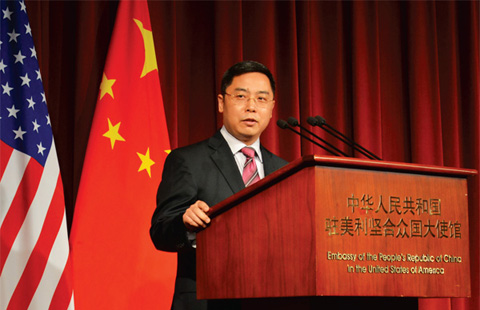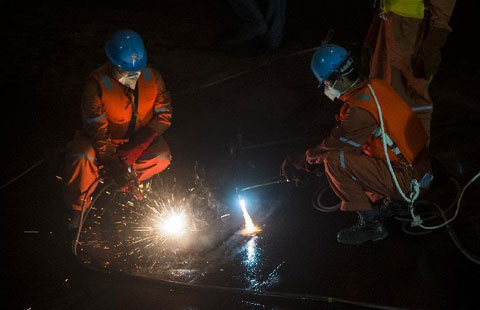Why Li Keqiang Index remains important benchmark
Updated: 2015-06-06 16:53
(chinadaily.com.cn)
|
||||||||
"Based on the interpretation of data available, it is safe to say "Li Keqiang" index is well matched with the signs and level of economic growth. The so-called "matching" mainly refers to basic consistency of trend in data change in highly related indicators, and does not involve synchronous and equidistant change in data," said the London Post commentary.
"Through comparison of indicators contained in "Li Keqiang Index" with GDP and industrial growth rate from 2003 to the first quarter of 2015, we can easily see that such indicators change in the same direction, that operation trends of such indicators are basically consistent and data are basically matched and that fluctuation of three indicators contained in "Li Keqiang Index" is larger than that of GDP and industrial growth rate.
"Between 2013 and the first quarter of 2015, average of GDP growth rate is 9.8 percent and fluctuation range1 is 7.2 percent; while average industrial growth rate is 13.3 percent and fluctuation range is 12.1 percent. Average growth rate of industrial power consumption volume, railway freight volume and medium and long-term loan balance is 9.5 percent, 4.2 percent and 20.7 percent respectively and corresponding fluctuation range reaches 16.6 percent, 20.4 percent and 34.5 percent respectively again," it added.
As China's economy undergoes shifts, its service sector will start playing a much bigger role in country's economic growth, claimed the Post.
It said that in 2012, 2013 and 2014, growth rate of the service sector was 0.4 percent, 0.7 percent and 1.1 percent higher than that of secondary sector. In the first quarter of 2015, this rate has even soared to 1.5 percent. In 2013, proportion of added value of the service industry in GDP was 46.9 percent, exceeding, for the first time, that of the secondary sector. That rate continuously increased to 48.2 percent in 2014 and to 51.6 percent in the first quarter of 2015.
This shows that the country's manufacturing base is witnessing major changes and that the "service industry has become the biggest industry of the economy as a whole." The rise of service sector also means that demand for railway freight will come down as services don't generate as much need for transportation of goods as manufacturing.
Another sector that is causing some major changes is the hi-tech industry. According to the Post, the growth rate of hi-tech industries was continuously higher than that of six major high energy-consuming industries, 1.7 percent and 4.8 percent higher in 2013 and 2014 respectively.
"In the first quarter of this year, the rate went up to 5.1 percent. Proportion of added value of hi-tech industries in total industrial added value soared to 11 percent in the first quarter of 2015 from 8.9 percent in 2011, a 2.1 percent increase, while proportion of added value of six major high energy-consuming industries decreased by 2.2 percent during the same period," it said.
With the Chinese government moving away from coal consumption to clean energy, the proportion of black gold in the energy sector will continue to fall.- Crews raise capsized ship to assist search
- China rescuers right ship to speed up search for missing
- More countries send condolences over China's cruise ship accident
- Test centers set stage for smooth gaokao
- 14 cities to draw red line to stop urban sprawl
- Personal items of sunken ship passengers found

 Across America (May 29- June 4)
Across America (May 29- June 4)
 Operation underway to turn the ship over
Operation underway to turn the ship over
 Prayers held for ship passengers
Prayers held for ship passengers Warriors beat Cavs in Game One OT thriller
Warriors beat Cavs in Game One OT thriller
 Cannavaro's Evergrande life in photos
Cannavaro's Evergrande life in photos
 Ten photos you don't wanna miss - June 5
Ten photos you don't wanna miss - June 5
 Chicago gets a present from Shanghai
Chicago gets a present from Shanghai
 Rescuers cut into capsized ship in search for survivors
Rescuers cut into capsized ship in search for survivors
Most Viewed
Editor's Picks

|

|

|

|

|

|
Today's Top News
Hacking claim isn't responsible, Beijing says
Startups return to China to battle pollution
Rescuers right ship to
speed up recovery
Overseas real estate investment hits record $7.5b in Q1
Editorial: Aquino shows a lack of sense or sensibility
60% of Chinese youth OK with premarital sex: survey
65 bodies found, more than 370 still missing
Ex-FIFA executive detailed bribes in 2013 secret guilty plea
US Weekly

|

|







